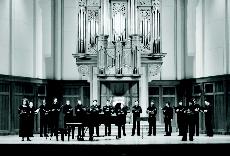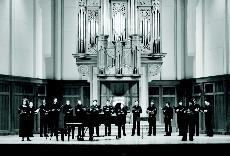
(rachele krivichi)
Featuring Liu Fang on pipa and Aditya Verma on sarod, the Lawrence World Music Series concert Feb. 1 in Harper Hall was the perfect escape from the stress that comes from midterms.
While some audience members seemed to be attending against their will – the UW student listlessly taking notes, the fidgeting kids in front, the Lawrentian reporter pulling out the Kleenex and cough drops – the mood changed when the sounds of the pipa began.
The pipa is a Chinese four-stringed lute, looking something like a guitar but held upright on the lap of the musician. That musician, in this case, was the lovely Liu Fang, an international prodigy who played before Queen Elizabeth II at age 11.
Rather than using a single pick as a guitarist might, Liu Fang had false fingernails on her entire right hand, which she used to strum, scratch, and even smack the metallic strings of the pipa.
The result was breathtaking. Visually, Liu Fang’s fingers effortlessly soaring left, right, up and down the instrument was a ballet unto itself. Musically, the pieces seemed otherworldly yet at the same time each full of their own character.
Fang began with “Songs from the Other Side of the Border,” a classic piece telling a tale of a woman from the Han dynasty who yearned for her native land having been betrothed to a barbarian prince.
Fang seemed to allow the pipa to tell the sad story itself, while she simply moved her magic fingers across the strings. Having wooed the audience with this serene and traditional style, Fang later showed off her technical skills in Jieming’s 1980 “New Variation of Tang Dynasty Liuyao-dance,” which indulged the audience in wild accelerandos, moody bass lines, and strange metallic sounds – almost like mice squeaking – when the picks flew past the strings.
The second half of the concert featured Aditya Verma on the sarod, a North Indian classical string instrument with four main strings, six rhythm and drone strings and 15 sympathetic strings, which are not played directly but resonate rich overtones.
Verma was accompanied by Dexter Raghunanan on tabla, a North Indian two-part drum. The artists sat relaxed, shoeless and cross-legged on an Oriental carpet, and the drone of the tuning instrument seemed to put the audience in a trance.
However, this trance was somewhat shattered when Verma announced the astounding fact that over 90 percent of Indian music is improvised, and most Eastern musicians never learn to read musical notation at all. Instead, the musician begins with a raga, “the melodic form upon which the artist improvises his performance,” according to the concert program.
Each raga has a particular rasa, or one of nine moods: romance, humor, pathos, anger, heroism, fear, disgust, amazement, or peace. The time of year and day also influence the particular character of the raga.
The recital then proceeds with five major sections: the slow alap, the rhythmic jor, the gat – in which the tabla first enters – the climactic jhala, and finally the optional romantic thurmi or dhun. In this way, a single musical expression is explored thoroughly in multiple emotional and musical settings, producing an almost meditative effect.
The sound of the sarod itself is soothing, rich, and heavy due to the number of strings. Since there are no frets, Verma was able to make use of glissandos, giving a sense of freedom to the pitches.
From the sounds of Fang’s ethereal pipa to the darker, introspective nature of Verma’s sarod, the concert was an otherworldly escape for the stressed, frozen and ill audience members. Though Western reality has, sadly, set back in, http://www.liufangmusic.net/ and http://www.aditya.org/ offer some opportunities to be enchanted once again by the music of the East.
In addition, the 2010 World Music Series will continue April 6 when Ted Levin gives an ethnomusicology lecture at 9 p.m. in room 156 of the Shattuck Hall of Music.

(rachele krivichi)
